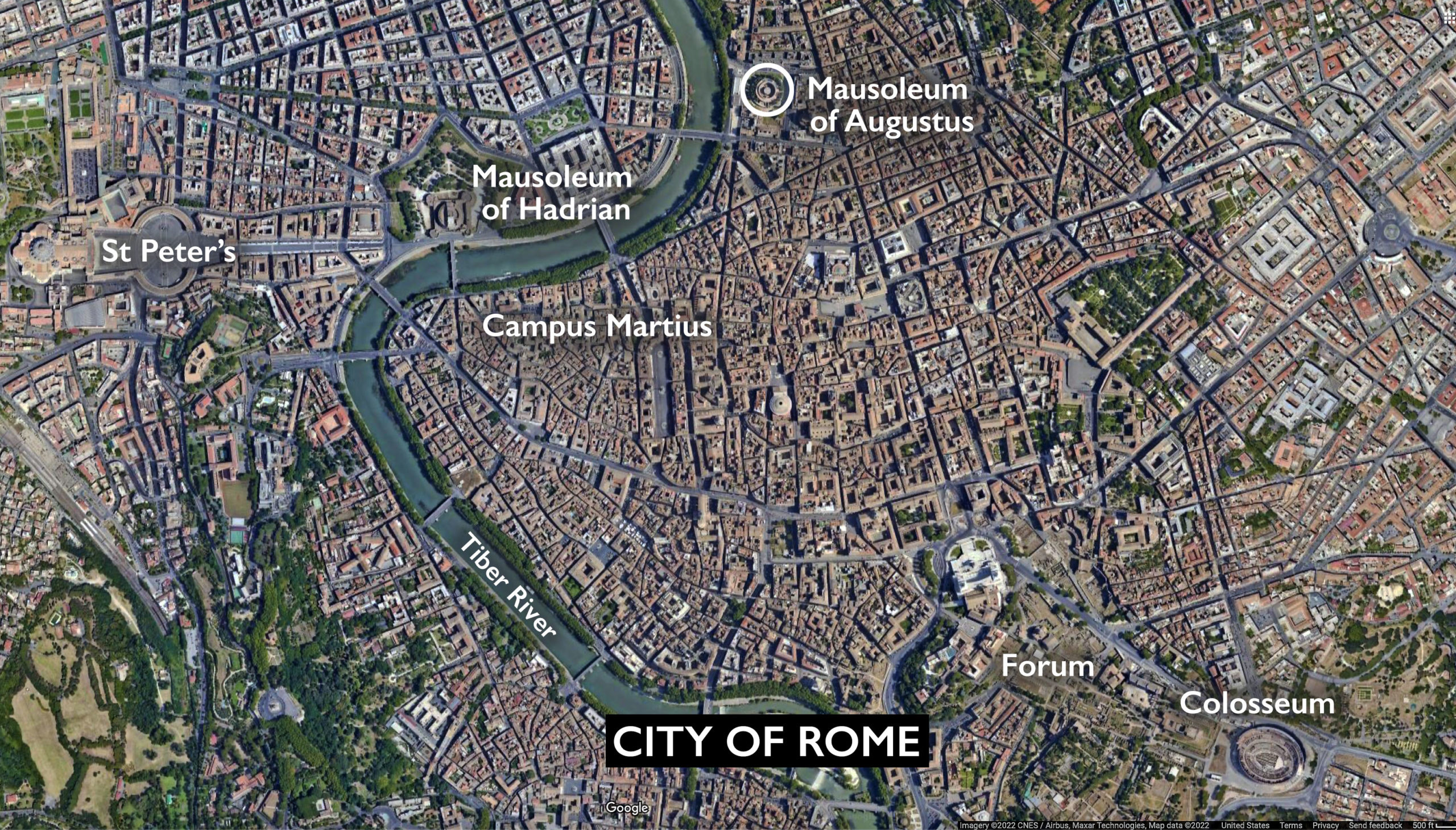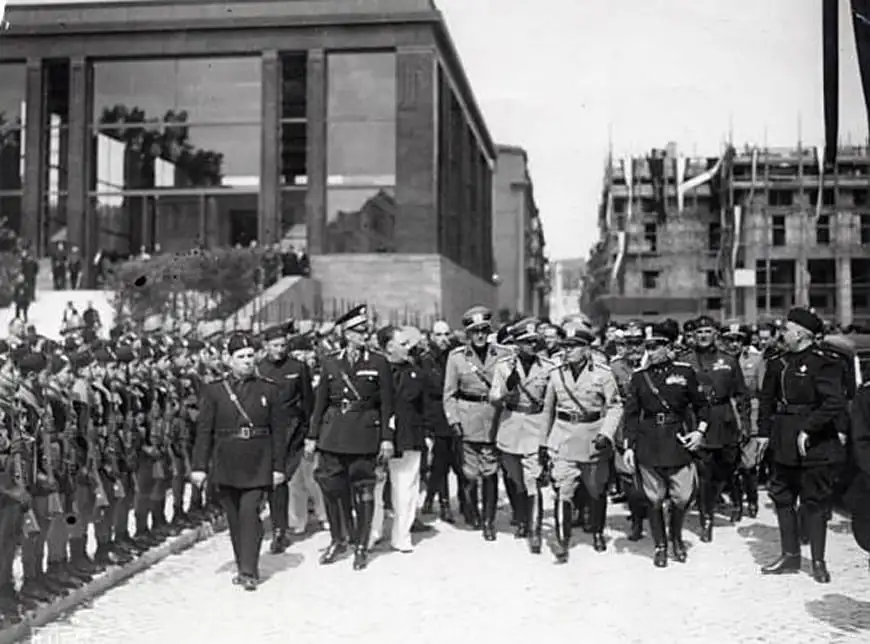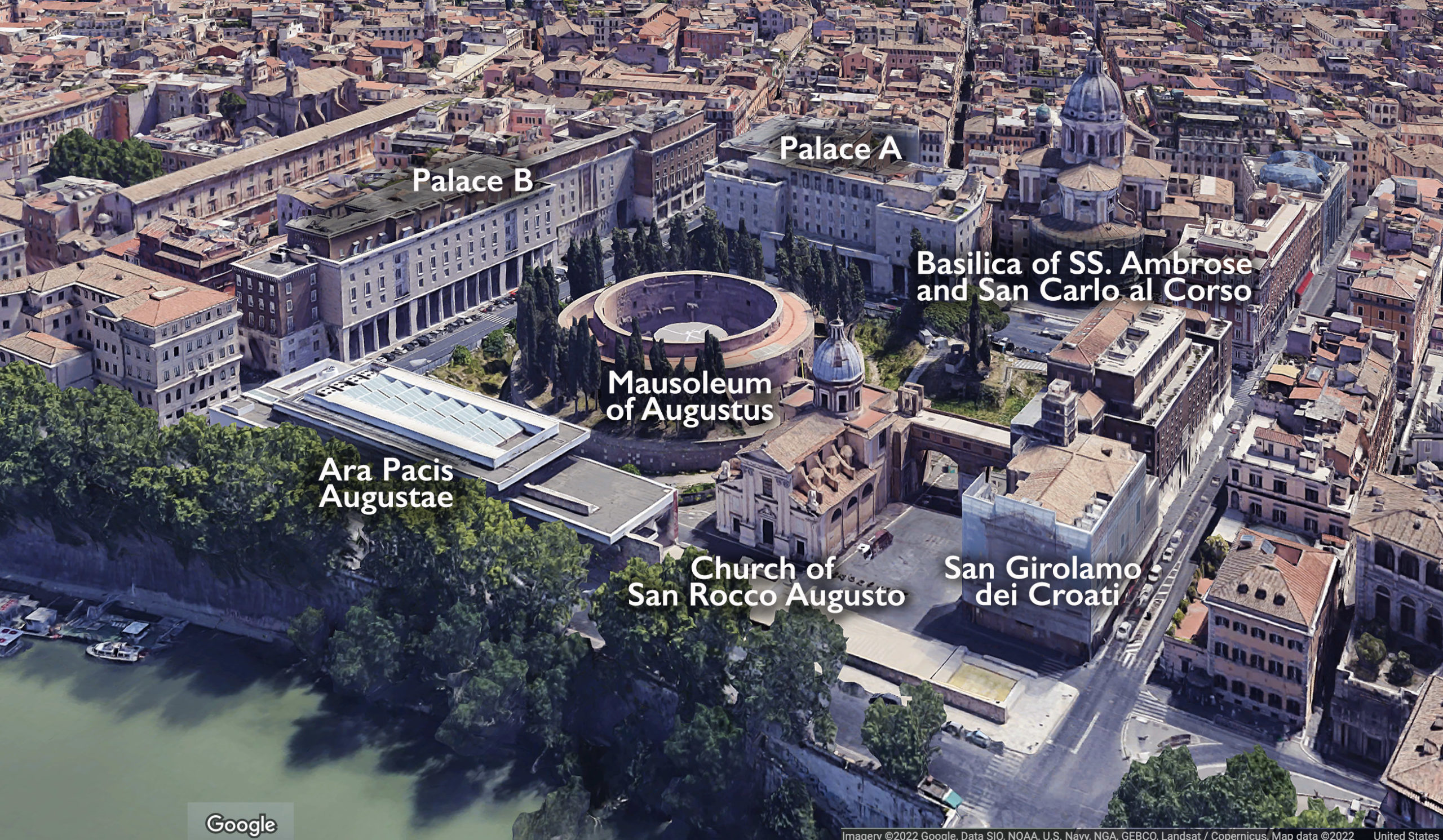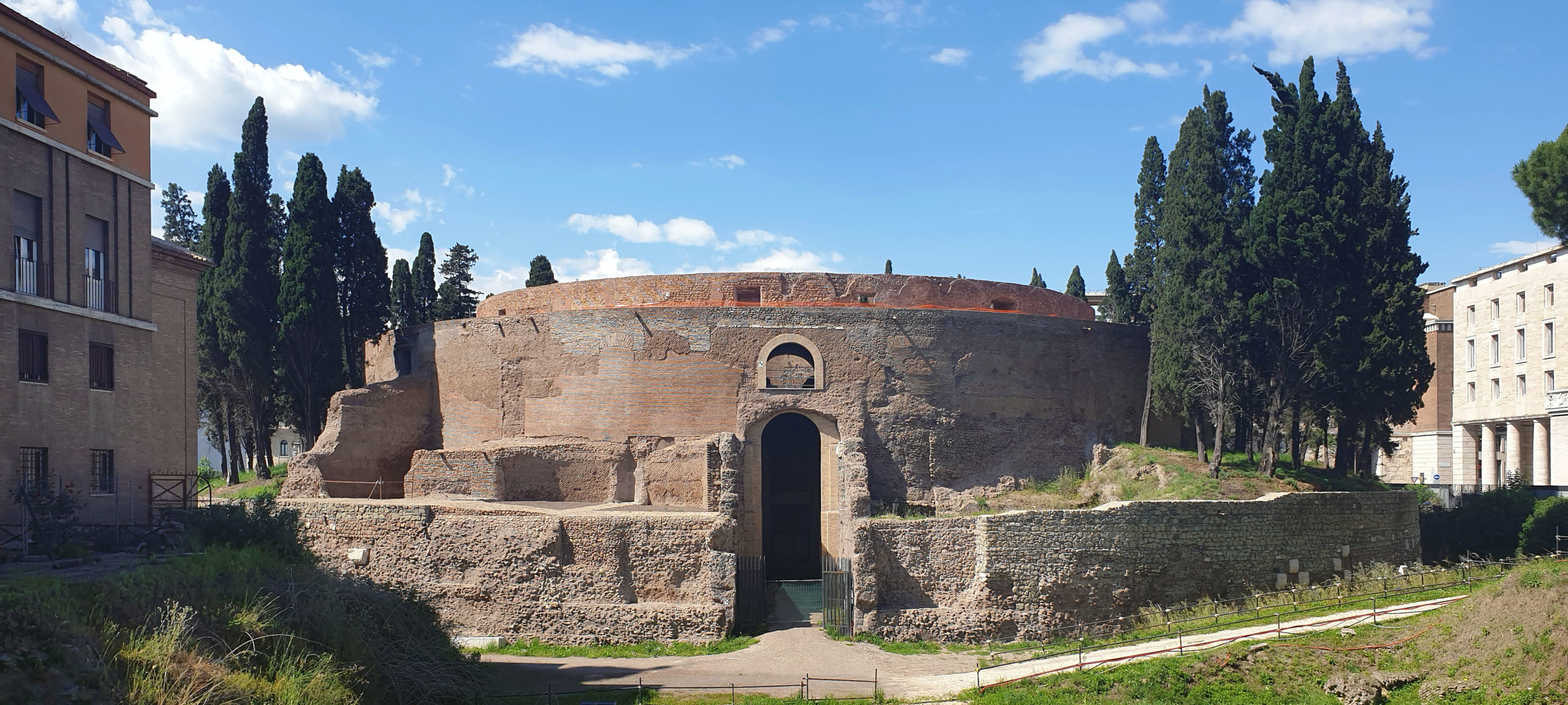
Ruins of the Mausoleum of Augustus, 28 B.C.E. as it appeared in 2019 (photo: Jamie Heath, CC BY-SA 2.0)
The Mausoleum of Augustus in Rome, a large circular tomb is a key monument for exploring the reuse, reinterpretation, and rediscovery of antiquities over time, and it has a long, complex history that continues to resonate today.
The tomb was constructed in 28 B.C.E. on the ancient military training grounds known as the Campus Martius (Field of Mars). It was commissioned by Gaius Octavius, the thirty-year old adopted heir to Julius Caesar who would become Emperor Augustus the following year. Enormous and elaborate, the Mausoleum represented the political ambitions of Augustus and his family, and made a public statement about his aspirations for permanent rule. The tomb’s burial chamber eventually held the ashes of Augustus, his family, and succeeding emperors of the patrician (noble) Julio-Claudian family. The maintenance of his legacy was so important to him that Augustus denied burial in the tomb to family members he considered disloyal to him—even his beloved and only natural-born child Julia.
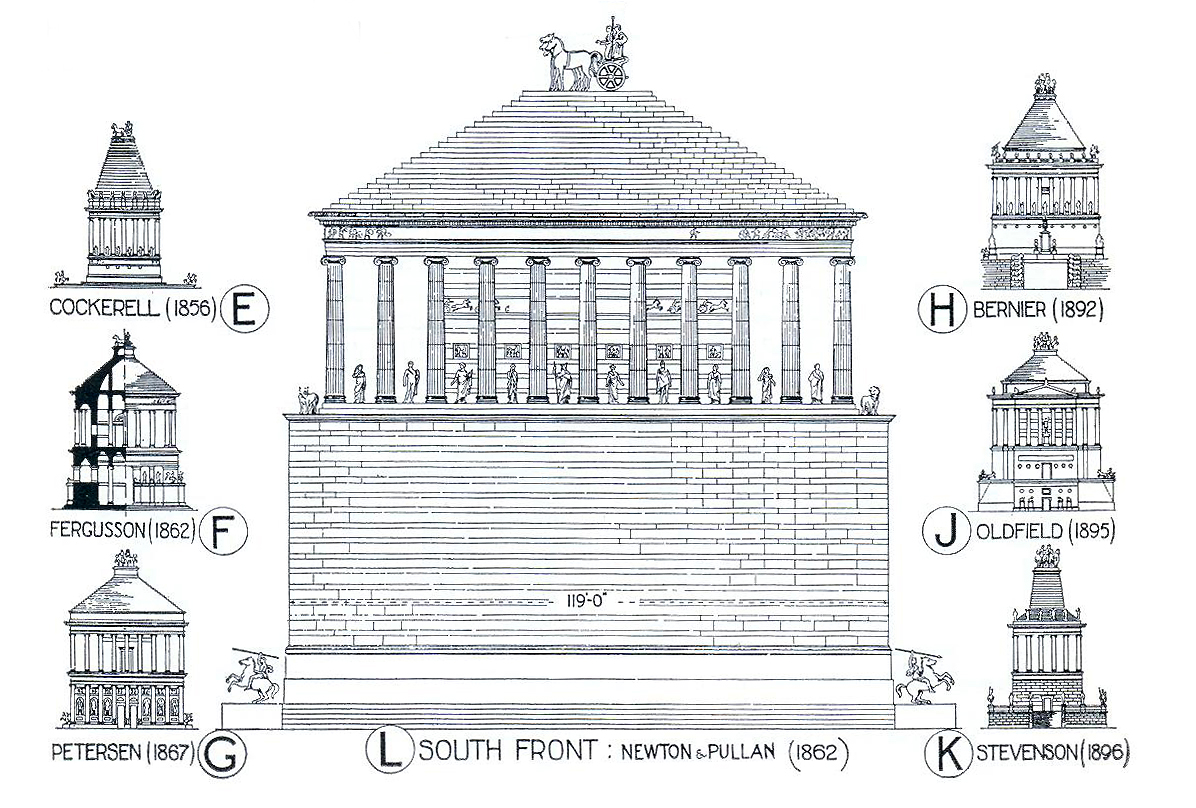
Speculative reconstructions of the Mausoleum of Halicarnassos from Sir Banister Fletcher, A History of Architecture on the Comparative Method for Students, Craftsmen & Amateurs (London, : B. T. Batsford, 1924), page 113.
Once likely clad in travertine (a light-colored limestone), Augustus’ mausoleum consisted of five concentric walls, with rooms in the outer two corridors supporting the building’s weight, and, following earlier Hellenistic tombs such as the monumental Mausoleum at Halicarnassus (c. 350 B.C.E.), a funerary room in the center contained family urns. Augustus’ urn was probably located in the middle of this room, directly below what is thought to have been a bronze statue of him in heroic pose atop the mausoleum.
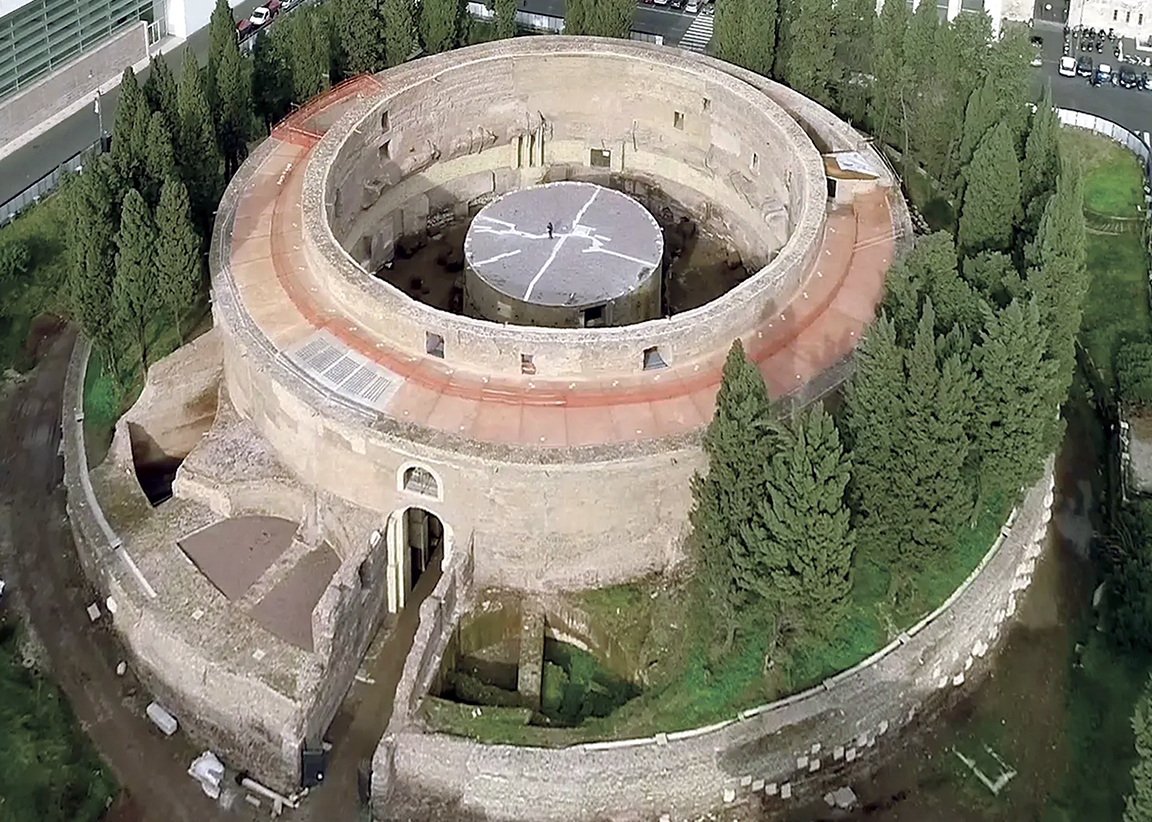
Aerial view of the mausoleum in 2019 showing the central cylinder housing Augustus’s burial chamber (photo: Sovrintendenza Capitolina ai Beni Culturali – Roma Capitale)
Archaeologists believe the mausoleum’s entry arch was approximately fifteen feet high and flanked by two bronze plaques engraved with Augustus’ Res Gestae Divi Augusti (Deeds of the Divine Augustus)—Augustus’ first-person account of his life and accomplishments. The entryway also displayed two pink granite obelisks that Augustus brought to Rome after his victory against Roman general Marcus Antonius (better known as Mark Antony) and his lover, Egyptian queen Cleopatra VII, at the naval battle of Actium (31 B.C.E.).
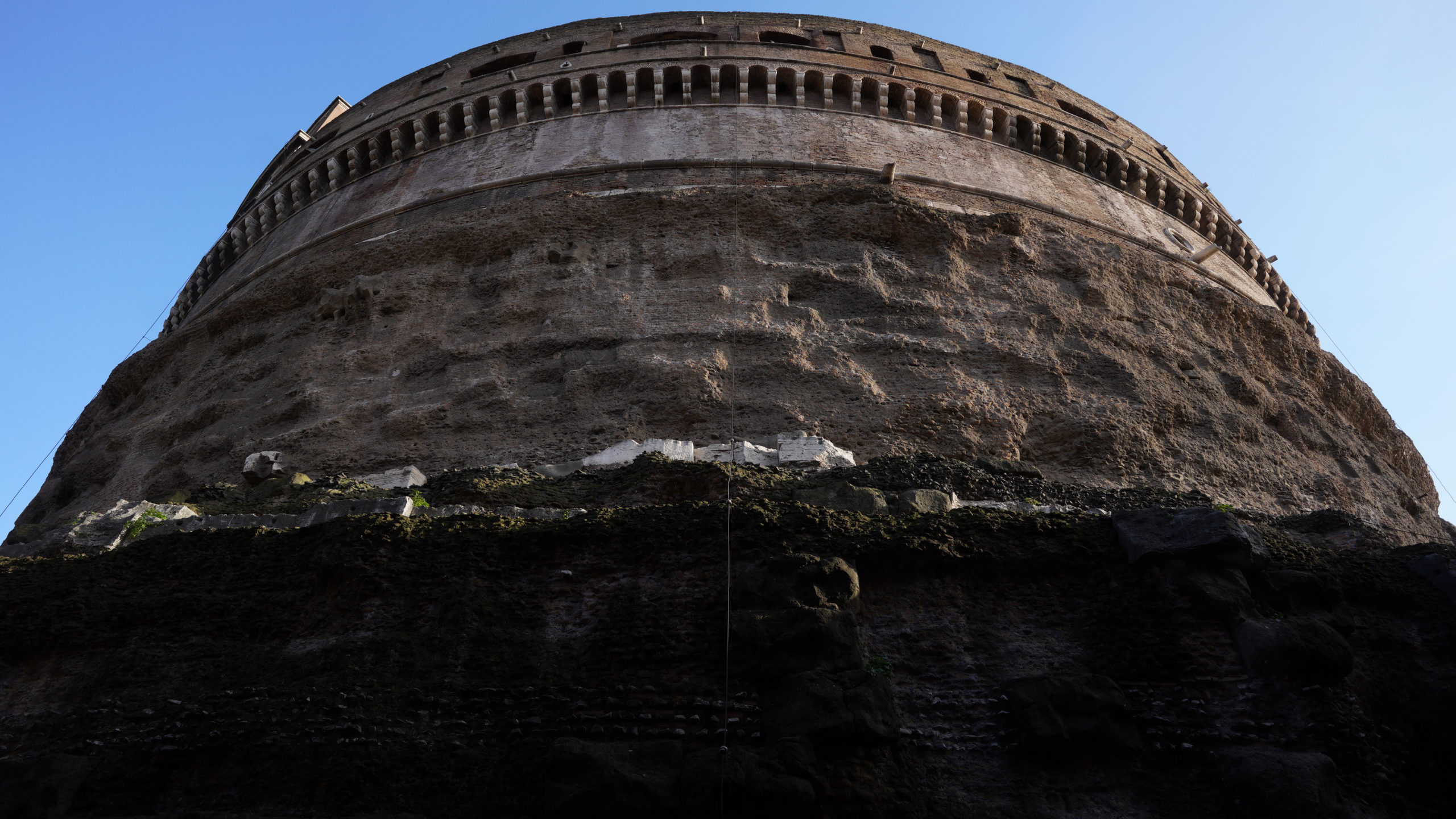
Medieval fortifications and traces of ancient travertine cladding, Mausoleum of Hadrian (Castel Sant’Angelo), Rome (photo: Steven Zucker, CC BY-NC-SA 2.0)
The Mausoleum through the ages
After being used as a tomb for more than a century, the mausoleum was abandoned. In the twelfth century, the noble Colonna family occupied the mausoleum and transformed it into a defensive castle. (Emperor Hadrian’s mausoleum across the Tiber River would undergo a similar transformation two centuries later, becoming the Castel Sant’Angelo). In the sixteenth century, the Florentine Soderini family purchased the mausoleum, and constructed a fashionable outdoor museum at the top with a hanging garden adorned with ancient statues.
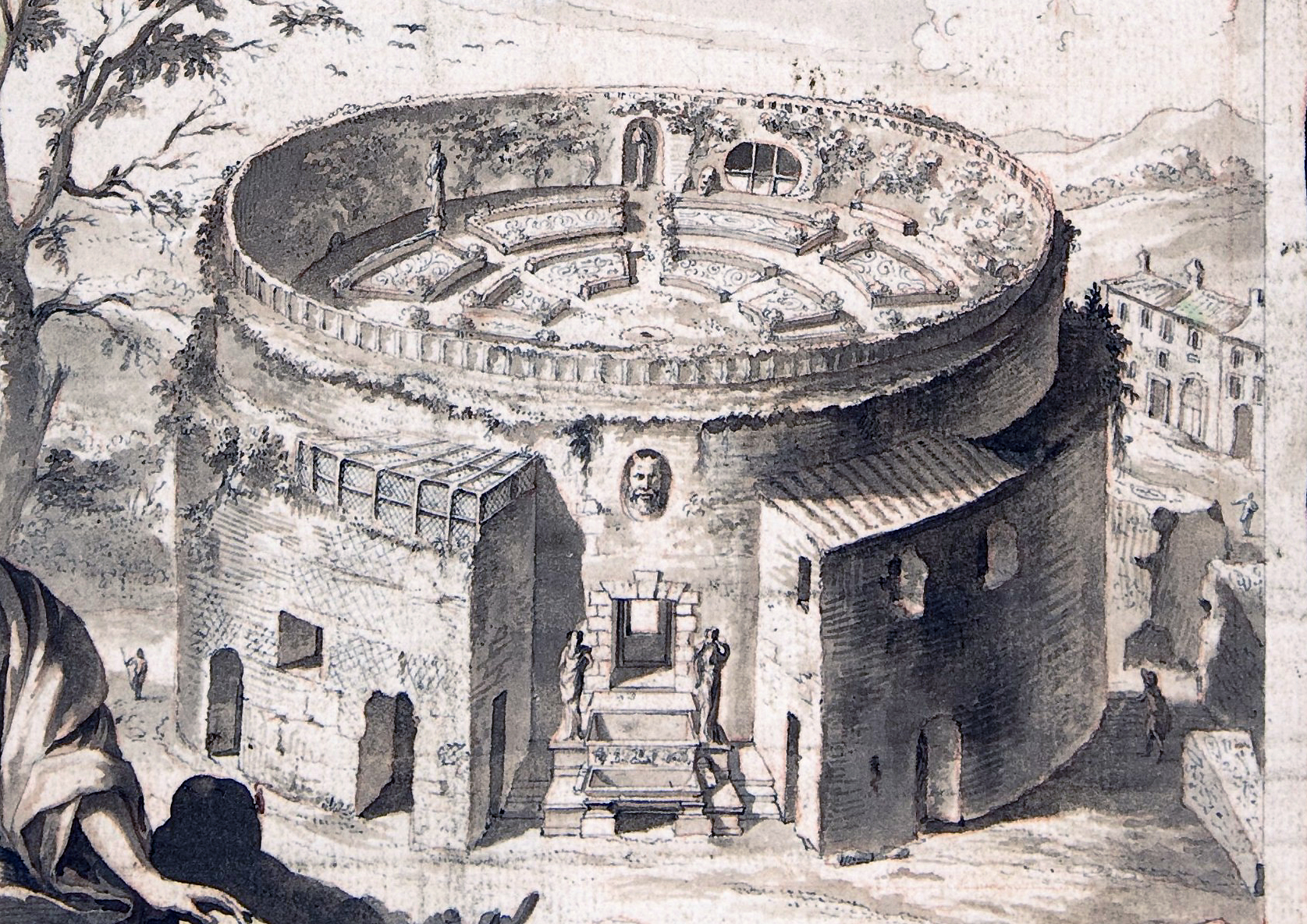
Garden (detail), Jan Goeree, A Reconstruction of the Mausoleum of Augustus and a View of the Ruins, before 1704, pen and black ink, brush and brown wash, red chalk, 33.4 x 20.6 cm (The Metropolitan Museum of Art)
By the eighteenth century, the Portuguese Marquis Benedetto Correa de Sylva transformed the mausoleum’s roof into an arena for the “Game of the Buffalo” (“Giostra della Bufala”—a spectacle resembling Spanish bullfights), and other tournaments and firework displays. Though the amphitheater subsequently changed owners, it continued as a venue for entertainment, even after passing into the hands of the Papal State (1802), the Kingdom of Italy (1873), and finally the Rome Municipality.
In 1908, restored and with a new stage on its ancient cylindrical base, the mausoleum was renamed the Auditorium Augusteo, and became one of the most renowned concert halls in Europe.
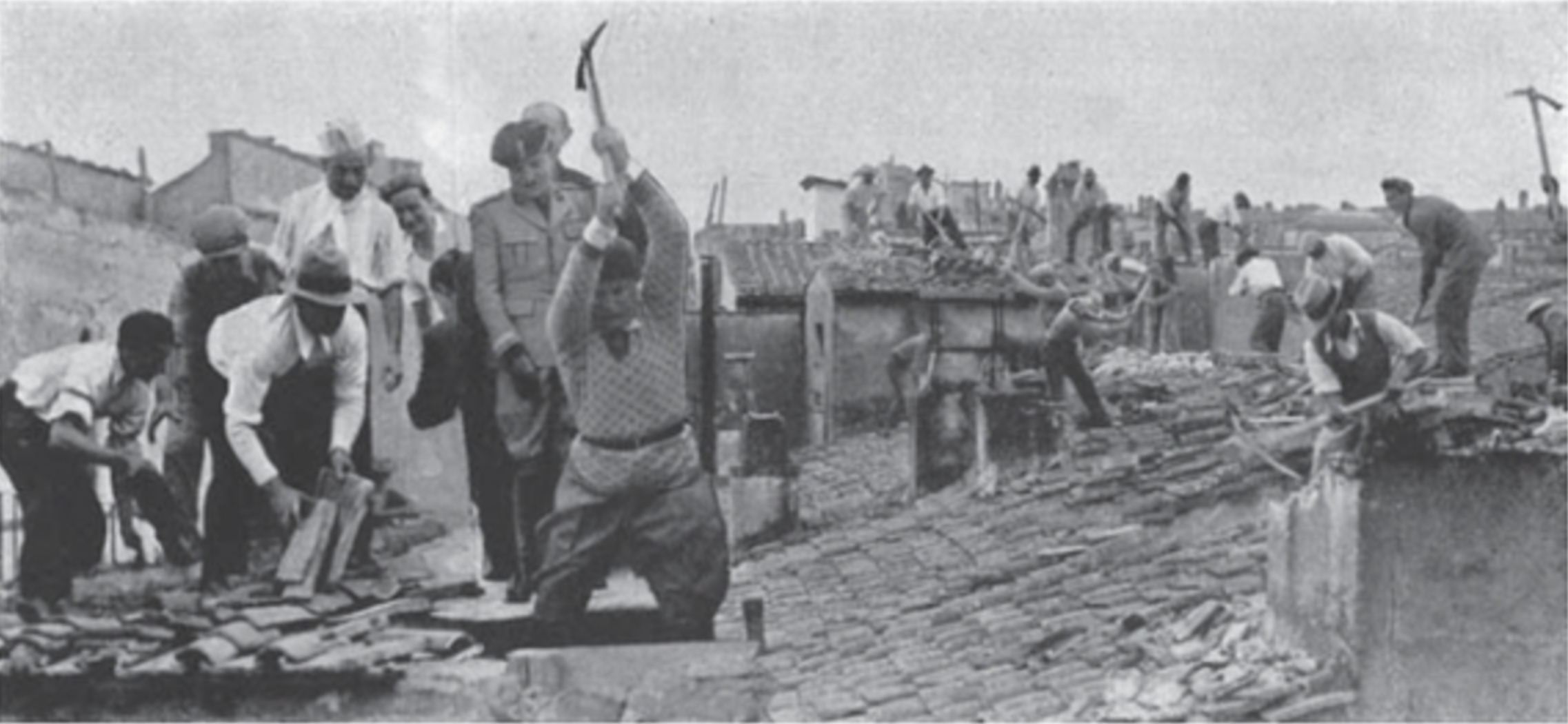
Primo colpo di piccone (First stroke of the pick), Mussolini swinging pickaxe near Mausoleum of Augustus from Giuseppe Moretti, “Lo scavo e la ricostruzione dell’Ara Pacis Augustae.” Capitolium, 1938: 479–490.
The Mausoleum in the early 20th century: fascism and a new piazza (Piazza Augusto Imperatore)
On October 22, 1934, during the height of the authoritarian Italian fascist regime (1922–45), the Mausoleum underwent a new, long-lasting refashioning. Dictator Benito Mussolini wielded a pickaxe for the cameras while he launched the massive demolition of more than 100 late-Renaissance buildings and other structures that had accumulated around Augustus’ Mausoleum over the centuries, and cleared nearly 100,000 square feet of land. Inspired by Romanita’, a cultish approach to Roman classical tradition, Mussolini wanted to “liberate” the ancient tomb of Augustus from later architecture and celebrate its imperial origins. Declaring (incorrectly) that countless archaeological treasures still existed inside the mausoleum, Mussolini toppled the famous Auditorium Augusteo and surrounded the mausoleum with roads and buildings, creating what is today the Piazza of Emperor Augustus (Piazza Augusto Imperatore) by 1937.
Mussolini initiates demolition to isolate the Mausoleum of Augustus, Newsreel, 1937 (Istituto Luce Cinecittà)
Mussolini’s unearthing of the Mausoleum was part of a larger government program called the Bimillenario that took place in 1938 to honor Emperor Augustus’ 2000th birthday. The fascist government considered the Emperor Augustus a “rare genius” who embodied the ideal imperial culture of ancient Rome. By associating Mussolini with Augustus, the administration felt they could further their propagandist goal of influencing their audiences and spreading their political message of the “genius of the dictator” (genio del duce).
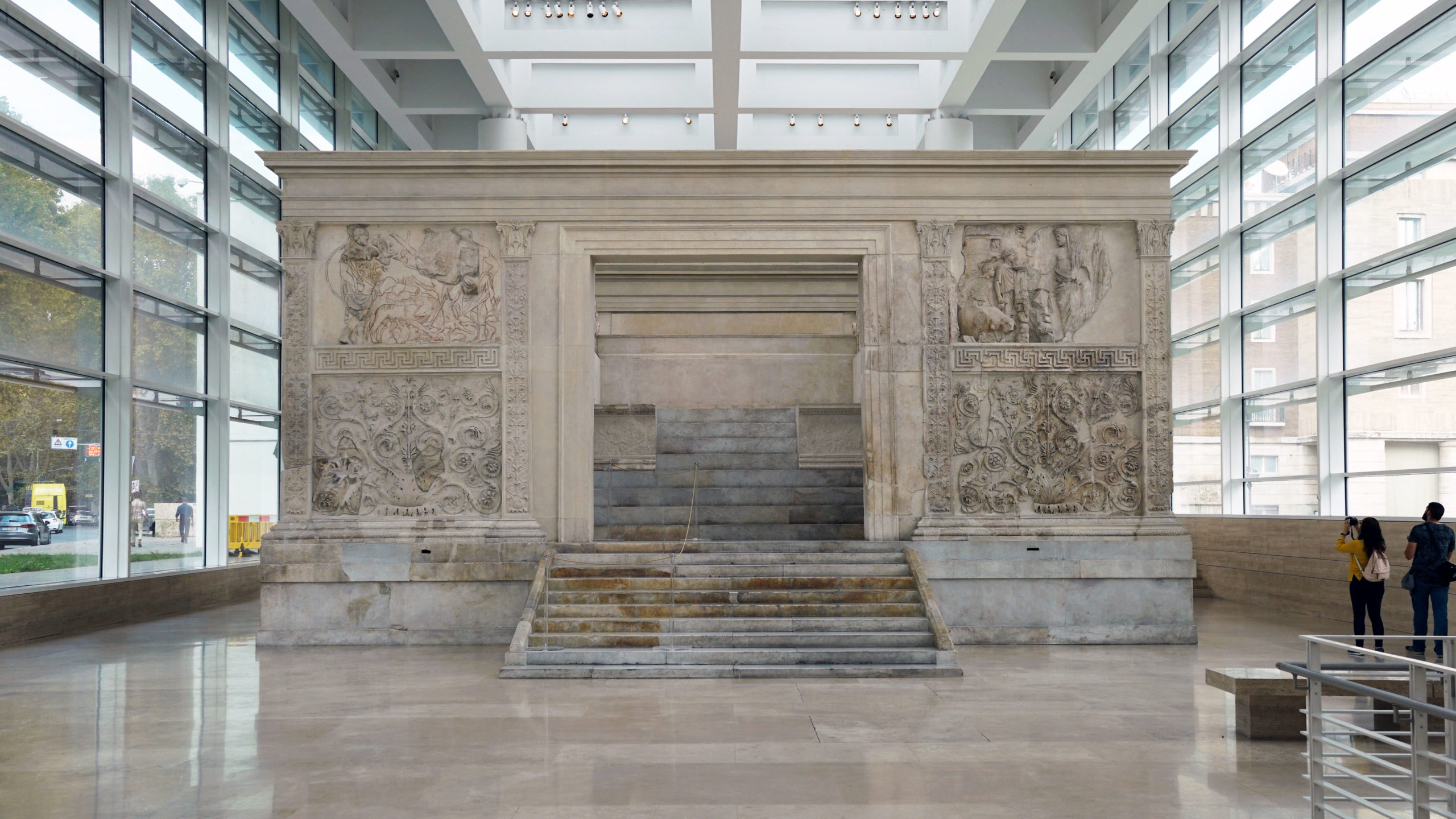
Ara Pacis Augustae (Altar of Augustan Peace), 9 B.C.E. (photo: Steven Zucker, CC BY-NC-SA 2.0)
A dictator’s reinterpretation of antiquity
During the construction of the Piazza of Emperor Augustus, fragments of the Augustan Altar of Peace (Ara Pacis) were unearthed from another part of the ancient Field of Mars, from beneath Palazzo Chigi (the official residence of the Italian prime minister). The Altar of Peace is an elaborate sacrificial altar built by Roman senators in 9 B.C.E. to honor Emperor Augustus’ military victories in Spain and Gaul. The altar’s decorative relief carvings included mythical founders of Rome and members of the Iulio-Claudian family. Such decoration appealed to the Fascist government as they sought to visually align their politics with a mythic, sacred past. Famous among antiquarians, pieces of the Ara Pacis had already been extracted in the 16th century and scattered all over the world, from the Uffizi in Florence to the Louvre in Paris.
As part of the Augustan celebrations, Mussolini ordered the repatriation, or return, of the missing pieces of the Ara Pacis, its full restoration, and a new highly visible location for it adjacent to the Mausoleum of Augustus (which was not its original site). Although it proved impossible to acquire all the missing pieces, the altar was reconstructed within a concrete-and-glass enclosure designed by architect Vittorio Ballio Morpurgo and a bronze copy of the Res Gestae was installed on its eastern side. On September 23, 1938, the 2000th birthday of Augustus, the Piazza of Emperor Augustus was inaugurated.
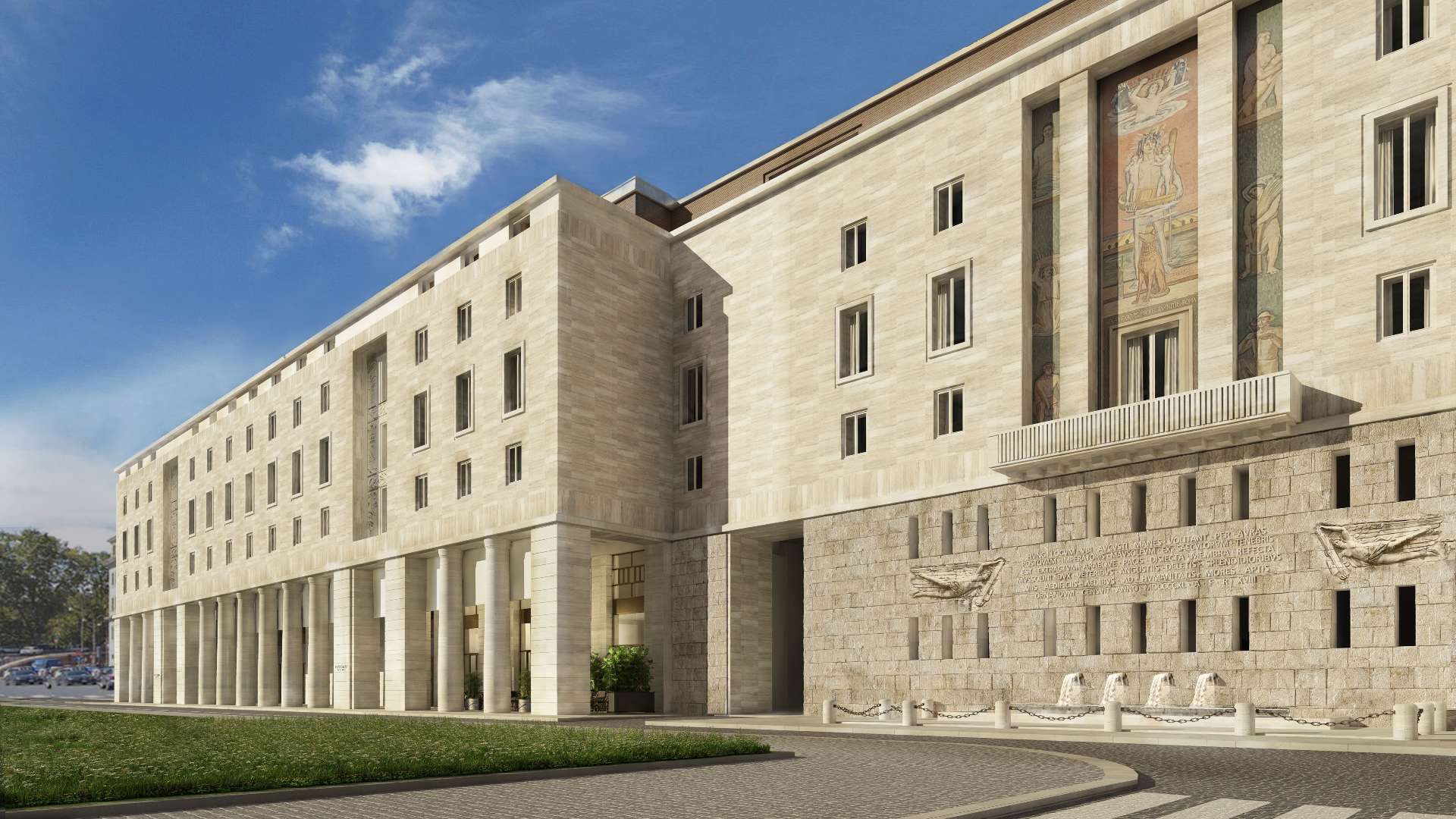
Vittorio Ballio Morpurgo, Instituto Nazionale office building also known as Palace B or Palazzo Nord, 1936–38 (photo: Bulgari Hotel Roma)
Palace B (Palazzo Nord) and buildings framing the piazza
To further define the Piazza of Emperor Augustus, Morpurgo designed three monumental buildings, fusing modern and classical styles and incorporating ancient Roman types of ornamentation, such as mosaics, relief carvings, and Latin inscriptions.
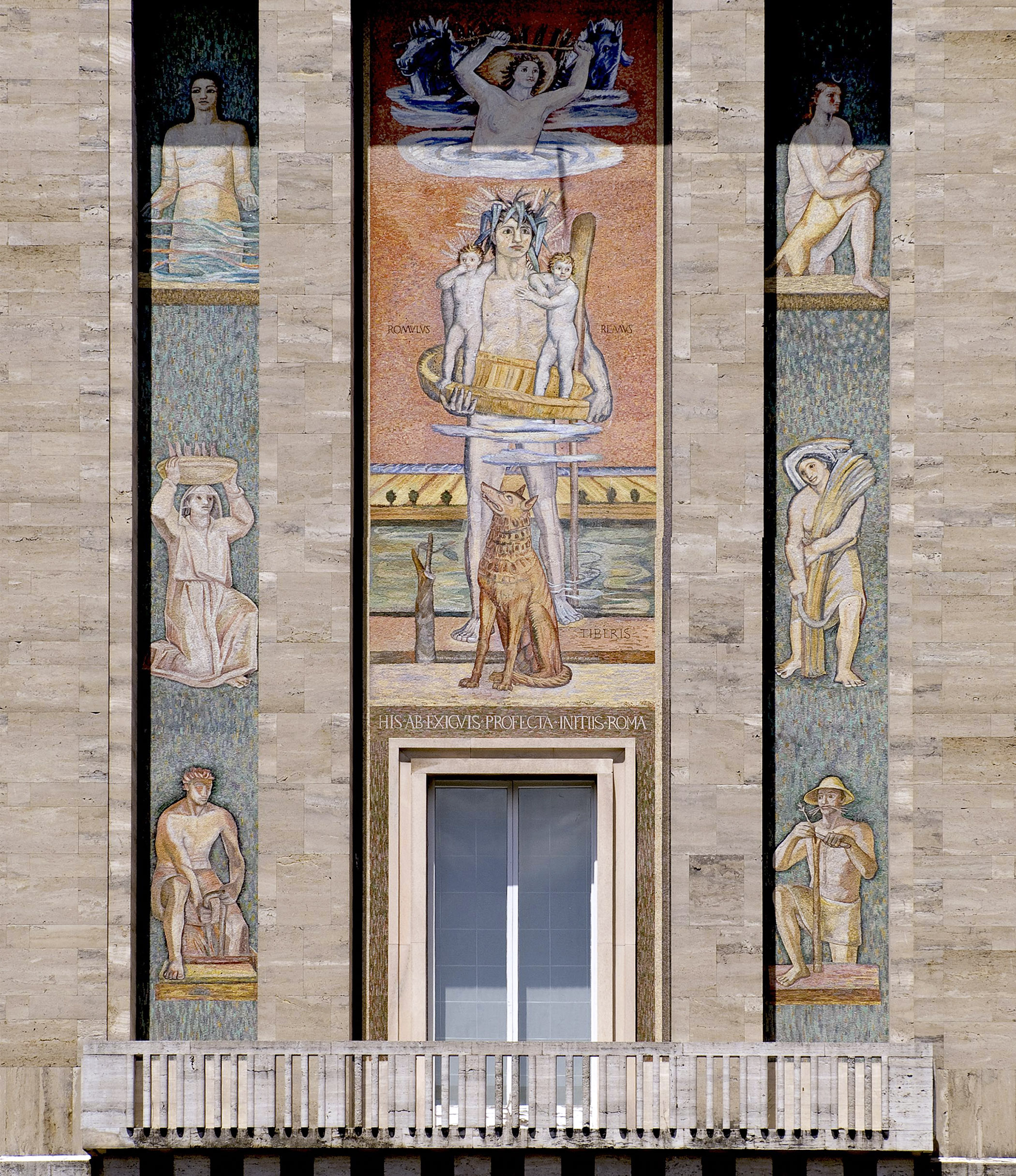
Ferruccio Ferrazzi, The Birth of Rome, 1938, mosaic, Istituto Nazionale Fascista Previdenza (Reed College)
A striking mosaic designed by Ferruccio Ferrazzi depicting “The Myth of Rome” appears on the façade of Morpurgo’s Palace B or Palazzo Nord, located along the north side of the mausoleum. Made with glazed ceramic tesserae (tiles) and divided into three sections, the standing youth in the center represents Rome’s Tiber River holding a boat containing Romulus and Remus, twin brothers of semi-divine parentage discovered on the river and believed to have founded Rome. A she-wolf, who nursed the twins, looks up from below. Above, Neptune, god of the sea, leads his horses. On either side, six divinities represent work and prosperity, themes important to the Fascist party.
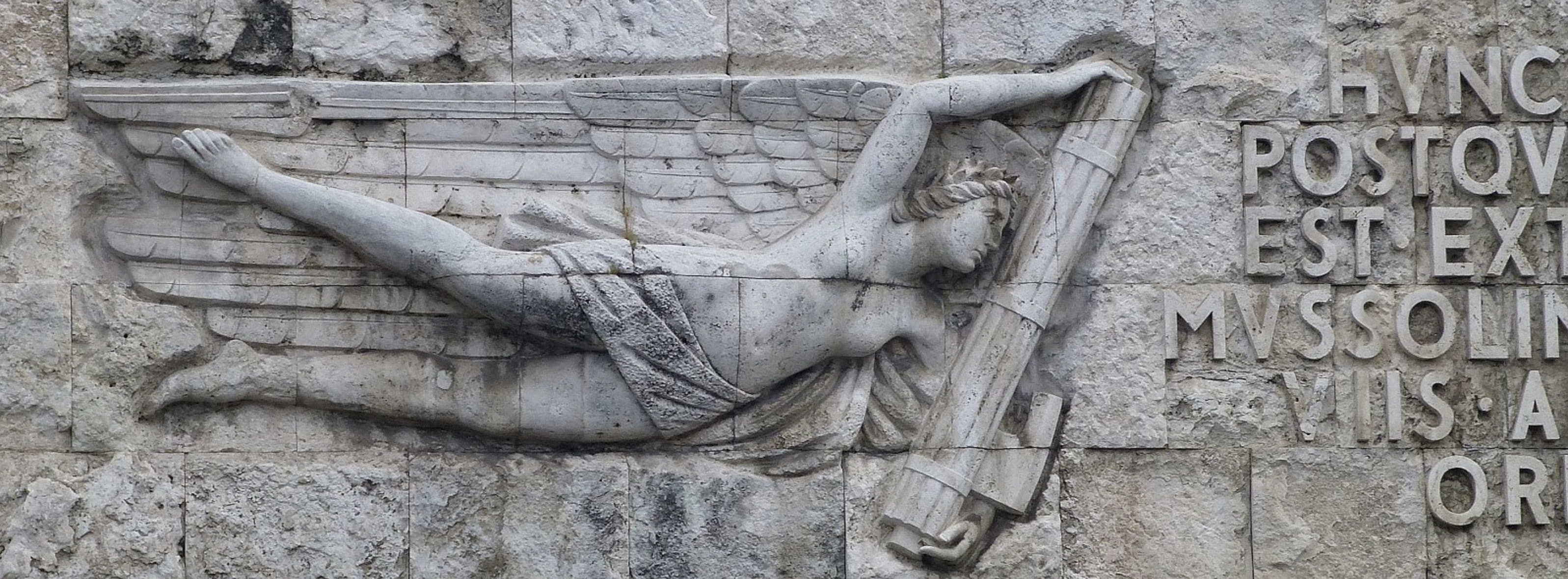
One of a pair of angels carrying a fasces, 1938, travertine relief, Istituto Nazionale Fascista Previdenza (photo: Martin G. Conde, FLICKR / RARA 2022 (11 June 2020, all rights reserved).
A Neo-Latin inscription below Ferrazzi’s mosaic, installed against rusticated stones and between two winged victories holding fasces (bundles of rods with axes symbolizing power in ancient Rome and reappropriated as a Fascist party symbol), honors and links Augustus and Mussolini.
Mussolini kept three Renaissance and Baroque churches intact in the Piazza of Emperor Augustus. Politics likely motivated his preservation of these ecclesiastical buildings, given a treaty he signed with the Vatican in 1929 that protected the Church financially and established Catholicism as the state religion. Morpurgo designed a brick overpass connecting two of the churches on the piazza’s west side (see photo above). Additionally, the imposing Baroque apse of Basilica of SS. Ambrose and San Carlo al Corso juts into the piazza’s east side. In this way, Mussolini literally framed the ancient Mausoleum of Augustus and unified Augustan, Christian, and Fascist Rome.
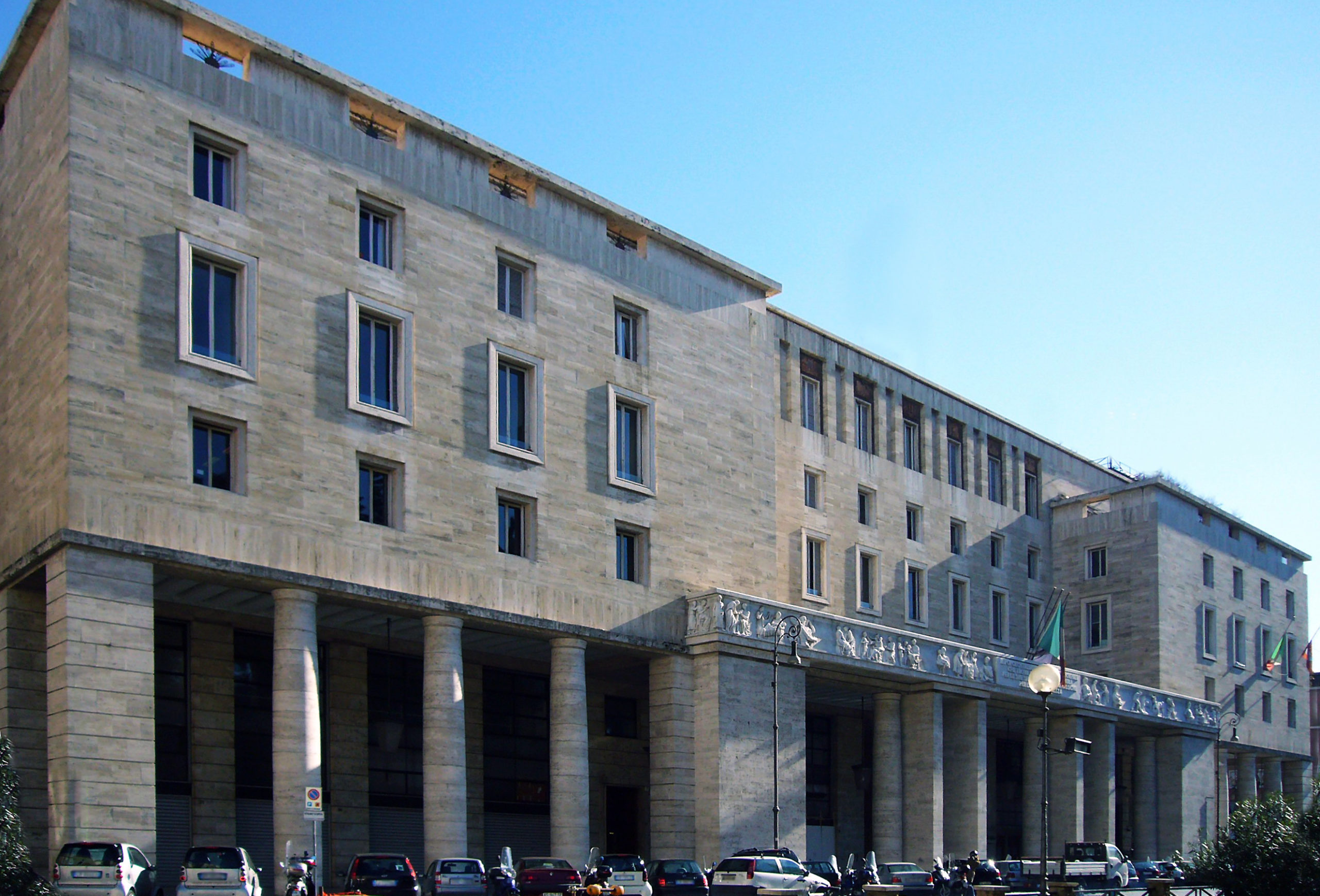
Vittorio Ballio Morpurgo, Instituto Nazionale office building also known as Palace A or Palazzo Est, Piazza Augusto Imperatore, 1936–38 (photo: Lalupa, CC BY-SA 4.0)
In the same year that Mussolini celebrated the Bimillenario of Augustus, he also established the Italian Racial Laws (Leggi Razziali), directed mainly against Jews and immigrants from Italy’s colonies in North and East Africa. Vittorio Morpurgo, the architect of Piazza Augusto Imperatore, was Jewish on his father’s side. In order to shield himself (the laws excluded Jews from holding public office, working in higher education, or for the fascist government), he declared himself non-religious and added his Catholic mother’s surname Ballio to Morpurgo.
Antiquity revealed in the 20th and 21st centuries
While Italy’s Fascist government was defeated at the end of World War II, the Piazza of Emperor Augustus and the ruins that Mussolini excavated remain, as do the Fascist-era buildings that frame them. Outlasting a fallen dictator, these important antiquities and surrounding modern buildings continue to be put to new uses and to offer new discoveries.
Over time, popular responses to the piazza and its ruins have changed. After World War II, the Piazza of Emperor Augustus became controversial, criticized as “blatantly Fascist.” By the early twenty-first century, the antiquities revealed by Mussolini, separate from their Fascist associations, became celebrated as exquisite objects of national, archaeological, and cultural significance. Today, while the Fascist-era decorations and architecture remain protected by a government zoning plan, the archaeological monuments such as the Ara Pacis Augustae are emphasized.
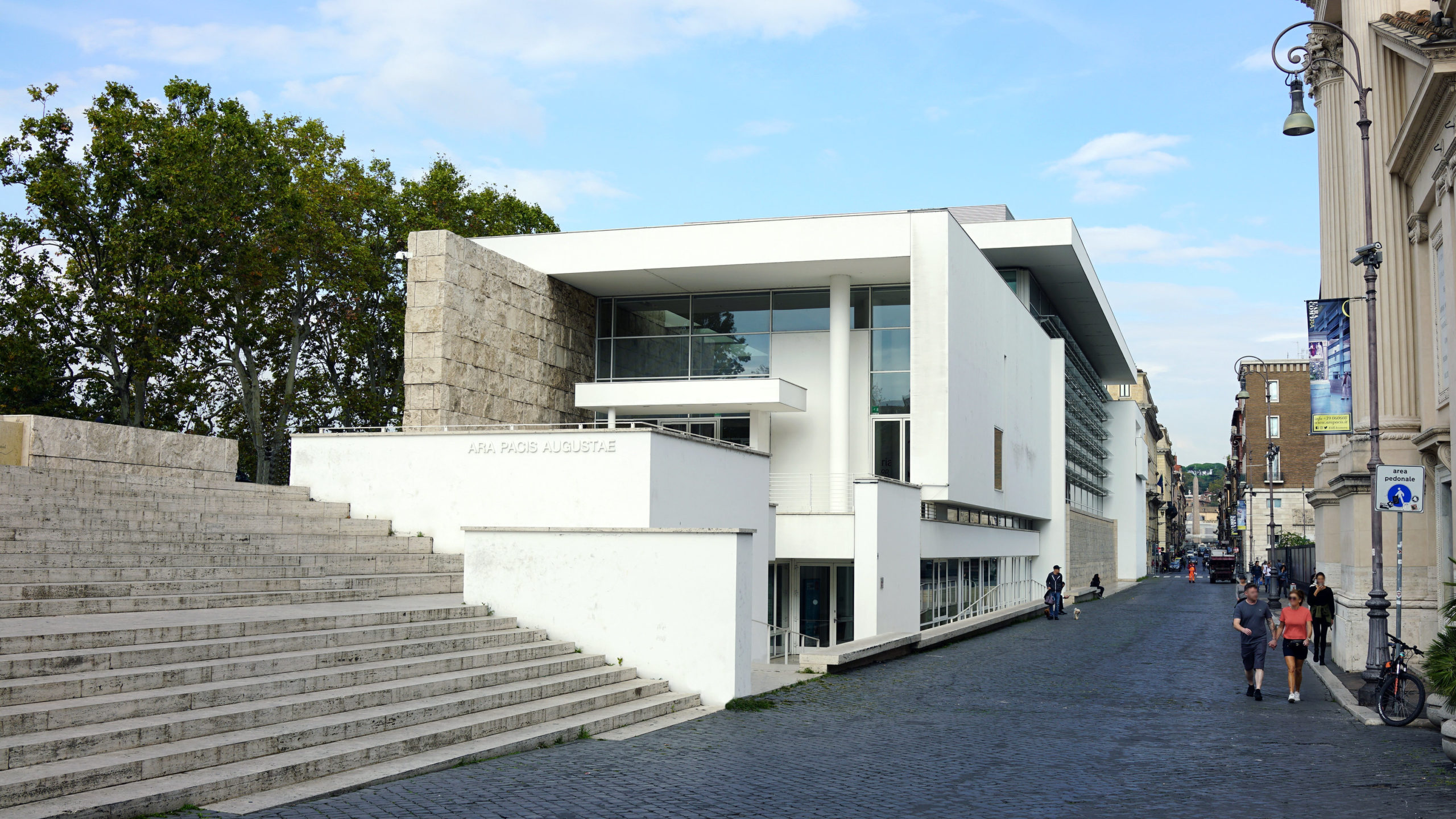
Richard Meier & Partners, Ara Pacis Augustae Museum, 1995–2006, Rome (photo: Steven Zucker CC BY-NC-SA 2.0)
In 2006, American architect Richard Meier designed a new enclosure for the Ara Pacis that replaced the protective shell created by Vittorio Ballio Morpurgo. With a fountain in front of the entrance, the new building is oriented on a north-south axis and has less of an association with the adjacent piazza. The museum display, supplemented with portraits of the Julio-Claudian family and a scale model of the Ara Pacis in its ancient setting, focuses more on Augustus than Mussolini.
Although long designated as a heritage site, Augustus’ Mausoleum itself is also undergoing a re-discovery. Archaeologists, architects, and curators are working with Rome’s Superintendency of Archaeology to complete archaeological fieldwork and prepare the site for visitor access. Although a difference in height exists between the original level of the mausoleum and the surrounding area, lead architect Francesco Cellini has designed a new entrance that meets the mausoleum’s original grade level and reveals more ancient travertine pavements, including the remains of a possible paved processional route that linked the tomb with the Pantheon in the Campus Martius. In this way, he and his team hope to “reinsert the monument into a network of urban relations.”
Reuse of Vittorio Morpurgo’s Palace B is also planned. The Italian luxury brand Bulgari, known for its glamorous jewelry, will install a high-end hotel inside. Palace B’s original ornamental features will reportedly be retained. But as with the new Ara Pacis Museum, the Bulgari Hotel emphasizes the ancient Imperial rather than the fascist past, quoting in their publicity only a portion of the façade’s Latin inscription devoted to Augustus: “This is the place where the Emperor Augustus’ soul flies through the air.” Mussolini, originally included in the inscription, is not mentioned, reminiscent of the ancient practice of damnatio memoriae, a Latin phrase meaning “condemnation of memory,” when a person is excluded from official historical accounts.
Additional resources
Susan L. Fugate Brangers, “Political propaganda and archaeology: The Mausoleum of Augustus in the Fascist Era,” International Journal of Humanities and Social Science 3, no. 16 (2013): pp. 125–35.
Aristotle Kallis, “‘Framing’ Romanità: The Celebrations for the Bimillenario Augusteo and the Augusteo–Ara Pacis Project,” Journal of Contemporary History 46, no. 4 (October 2011): pp. 809–31. https://doi.org/10.1177/0022009411413407.
Spiro Kostoff, “The Emperor and the Duce: The Planning of the Piazzale Augusto Imperatore in Rome,” in Art and Architecture in the Service of Politics, edited by Henry A. Millon and Linda Nochlin (Cambridge, MASS: MIT Press, 1978), pp. 270–325.
Jan Nelis, “Constructing Fascist Identity: Benito Mussolini and the Myth of ‘Romanità,’” The Classical World 100, no. 4 (2007): pp. 391–415.
Anna Maria Riccomini, “A Garden of Statues and Marbles: The Soderini Collection in the Mausoleum of Augustus,” Journal of the Warburg and Courtauld Institutes 58 (1995): pp. 265–84.
Henner von Hesberg and Silvio Panciera, “Das Mausoleum des Augustus: Der Bau und seine Inschriften,” in Bayerische Akademie der Wissenschaften Philosophische-Historische Klasse, Suppl. 108 (Munchen, 1994).
John Seabrook, “Roman renovation: Richard Meier tries to the conquery the Italians,” The New Yorker (May 2, 2005): pp. 56–63.
Ann Thomas Wilkins, “Augustus, Mussolini, and the Parallel Imagery of Empire,” in Donatello Among the Blackshirts. History and Modernity in The Visual Culture of Fascist Italy, edited by Claudia Lazzaro and Roger J. Crum (Ithaca and London: Cornell University Press, 2005), pp. 53–66.

